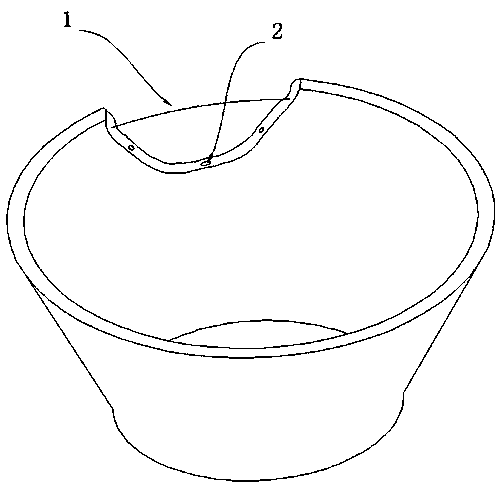Matching repair technique for porcelain
A porcelain and supplementary technology, which is applied in the field of porcelain restoration, can solve the problems of poor strength of the repaired part, poor connection effect between the repaired part and the mother embryo, and fragility, so as to improve the strength of the repair, improve the connection strength, hardness and stability Effect
- Summary
- Abstract
- Description
- Claims
- Application Information
AI Technical Summary
Problems solved by technology
Method used
Image
Examples
Embodiment 1
[0028] like figure 1 As shown, a porcelain complement restoration technique includes the following steps:
[0029] (1) Open blind holes 2 at the mother embryo of the porcelain wound. The diameter of the blind hole 2 is 5mm. Too large blind holes 2 may damage the structure of the mother embryo. Take three blind holes 2 and distribute them evenly at a distance of 15mm. The depth of the blind hole 2 is 2 mm, and the hole is drilled to install the fixing rod 1. The fixing rod 1 is placed on the upper edge of the wound as much as possible, so that the barbed wire wrapped around the fixing rod 1 can cover as large an area as possible;
[0030] (2) Use scissors to cut out a barbed wire mesh in the shape of a porcelain wound. The hole diameter of the barbed wire mesh is 2mm. The size of the barbed wire mesh is basically determined to cover most of the wound area. The barbed wire wraps around the fixed rod 1 on the side close to the fixed rod 1 and hangs it. Form a relatively fixed su...
Embodiment 2
[0035] (1) Open blind holes 2 at the mother embryo of the porcelain wound. The diameter of the blind hole 2 is 2mm. Too large blind holes 2 may damage the structure of the mother embryo. Take 5 blind holes 2 and distribute them evenly at a distance of 10mm. The depth of the blind hole 2 is 1mm, and the hole is drilled to install the fixing rod 1. The fixing rod 1 is placed on the upper edge of the wound as much as possible, so that the barbed wire wrapped around the fixing rod 1 can cover as large an area as possible;
[0036] (2) Use scissors to cut out a barbed wire mesh in the shape of a porcelain wound. The hole diameter of the barbed wire mesh is 2mm. The size of the barbed wire mesh is basically determined to cover most of the wound area. The barbed wire wraps around the fixed rod 1 on the side close to the fixed rod 1 and hangs it. Form a relatively fixed support on the wound surface;
[0037] (3) Use plastic clay on the outer surface of the porcelain wound, and the int...
PUM
| Property | Measurement | Unit |
|---|---|---|
| diameter | aaaaa | aaaaa |
| pore size | aaaaa | aaaaa |
| pore size | aaaaa | aaaaa |
Abstract
Description
Claims
Application Information
 Login to View More
Login to View More - R&D
- Intellectual Property
- Life Sciences
- Materials
- Tech Scout
- Unparalleled Data Quality
- Higher Quality Content
- 60% Fewer Hallucinations
Browse by: Latest US Patents, China's latest patents, Technical Efficacy Thesaurus, Application Domain, Technology Topic, Popular Technical Reports.
© 2025 PatSnap. All rights reserved.Legal|Privacy policy|Modern Slavery Act Transparency Statement|Sitemap|About US| Contact US: help@patsnap.com

